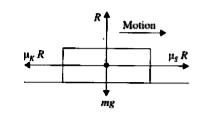When is a body said to be in motion ?
Step-by-Step Text Solution:
1. Definition of Motion: A body is said to be in motion when it changes its position over time. This means that if you observe the body from a particular point, you will notice that its location is not constant.
2. Reference Point: To determine if a body is in motion, we need a reference point or an observer's frame of reference. This could be a stationary object or a specific location in space.
3. Continuous Change: The change in position must be continuous. This means that the body should not just move once and stop; rather, it should keep changing its position relative to the reference point.
4. Time Factor: The aspect of time is crucial. The change in position must occur over a period of time. If a body remains in the same position for a duration, it is considered to be at rest, not in motion.
5. Immediate Surroundings: Additionally, a body can also be considered in motion if its position changes with respect to its immediate surroundings. For example, if you are sitting in a moving car, you are in motion relative to the trees and buildings outside.
Final Conclusion: Therefore, a body is in motion when it continuously changes its position with respect to time or its immediate surroundings.
---
Topper's Solved these Questions
- MOTION IN ONE DIMENSION BOOK - ICSECHAPTER - MOTION IN ONE DIMENSION EXERCISE - EXERCISE -2 (A) ( Multiple choice type: )
5 Videos
- MOTION IN ONE DIMENSION BOOK - ICSECHAPTER - MOTION IN ONE DIMENSION EXERCISE - EXERCISE -2 (A) ( Numericals )
16 Videos
- MOTION IN ONE DIMENSION BOOK - ICSECHAPTER - MOTION IN ONE DIMENSION EXERCISE - EXERCISE -2 (C) ( Multiple choice type :)
17 Videos
- MEASUREMENTS AND EXPERIMENTATION BOOK - ICSECHAPTER - MEASUREMENTS AND EXPERIMENTATION EXERCISE - TOPIC 2 SIMPLE PENDULUM (4 Marks Questions )
1 Videos
- PRESSURE IN FLUIDS AND ATMOSPHERIC PRESSUREBOOK - ICSECHAPTER - PRESSURE IN FLUIDS AND ATMOSPHERIC PRESSUREEXERCISE - Exercise -4(B)Numericals
5 Videos
Similar Questions
Knowledge Check
A rigid body is said to be in partial equilibrium, when it is in
Aa. translational equilibrium onlyBb. rotational equilibrium onlyCc. either (a) or (b)Dd. neither (a) nor (b)For a body on a horizontal surface, coefficients of static and kinetic frictions are 0.4 and 0.2 respectively. When the body is in uniform motion on the surface, a horizontal force equal in magnitude to limiting friction is applied on it. The acceleration produced is
 A0.4gB0.1 gC0.2 gD0.6 g
A0.4gB0.1 gC0.2 gD0.6 g
When is a body said to be at rest?
View SolutionA body is said to be in uniform motion if it has uniform velocity.
View SolutionWhen is a molecule said to be chiral?
View SolutionDefine work. When is work said to be done by a force ?
View SolutionThe energy possessed by a body due to its motion is called ................ energy
View SolutionAssertion : A projectile should have two component velocities in two mutually perpendicular directions .
Reason : A body is said to be projectile if it has motion in two dimensions.
View Solution
